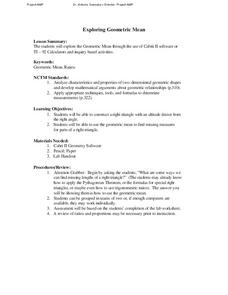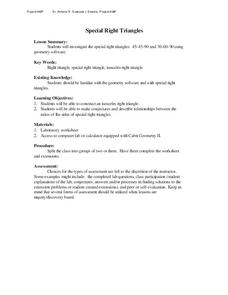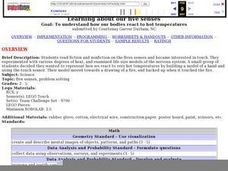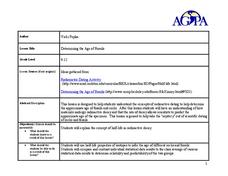Curated OER
What's The Matter: A Sinker or Floater?
Young scholars conduct an experiment. In this water lesson, students watch the lesson "Float and Sink" on an interactive website. Young scholars learn how to test items in water and then work in groups to test their items. Students...
Curated OER
Investigating Trigonometric Ratios Through Similar Right Triangles.
49Learners investigate the properties of right triangles. In this geometry activity, students differentiate between similar and congruent triangles. They use the Pythagorean Theorem to find the missing angles and sides.
Curated OER
Investigating Trigonometric Ratios Through Similar Right Triangles
Students identify similar and congruent right triangles. In this geometry instructional activity, students use trigonometric ratios to identify missing sides and angles of a triangle. They differentiate similar and congruent triangles.
Curated OER
Exploring Geometric Mean
Students solve problems using geometric means. In this geometry lesson, students create altitudes in right triangles. They use Cabri software to move the triangle around and observe different sides and angles.
Curated OER
Exploring Geometric Mean
Student identify the solution using geometric mean. In this geometry instructional activity, students create right triangles where the altitude of the triangle is the side containing the right angle. They modify shapes using Cabri...
Curated OER
Investigating Pythagorean Triples
Students investigate and solve Pythagorean triples. In this geometry lesson, students find the missing sides and angles of a right triangle. They graph right triangles and move the sides around to create different angles.
Curated OER
Investigating the Pythagorean Triples
Learners investigate the Pythagorean triples. In this geometry lesson plan, students solve for different parts of a right triangle. They identify the missing side or angle using the pythagorean theorem.
Curated OER
Teaching Biology Through Problem-based Activities
Students plant seeds and observe the life cycle of the organism. They experimentally research the effects of radiation on seed growth. Students determine the effects of environmental pollutants on harvested seed.
National Science Teachers Association
Hop into Action
Young scientists find out what makes amphibians such unique and interesting animals in this simple life science activity. After looking at pictures and discussing the characteristics of amphibians, learners complete a series of three...
Curated OER
Heron's Formula
Students use Heron's formula to calculate the area of a triangle. In this geometry lesson, students use three different methods to solve the area of a triangle. They find and construct the incentor and angle bisector of a triangle.
Curated OER
Special Right Triangles
Students identify different types of special right triangles. In this geometry lesson, students differentiate between right triangles and isosceles triangles. they construct the triangles using geometry software and make conjectures...
Curated OER
Principles of Flight: Where are We?
Young scholars explore the concept of topographical maps. In this topographical map lesson, students discuss how airplanes know where to fly. Young scholars use topographical maps to simulate a field trip on the computer.
Curated OER
Learning About Our Five Senses
Students study the sense of touch and various degrees of heat. They design a model that displays how the human hand reacts to heat using a touch sensor.
Curated OER
Untitled Document Aerospace Team Online:
Students explain the historical significance of use of the scientific method in developing the first airplane and appreciate the process involved in developing a new technology.
Curated OER
Determining the Age of Fossils
Students examine the concept of radioactive dating. In this radioactive dating lesson plan, students investigate how to determine the ages of fossils and rocks as they learn about half-life radioactive decay.
Curated OER
Rain, Rain, Go Away
Students conduct a number of experiments involving evaporation and condensation. They view and discuss a video about the water cycle and then design posters about the rain based on the book "Cloudy With A Chance of Meatballs".
Curated OER
Radiation Reassessed
Young scholars investigate the dangers of radiation by exploring recent nuclear tragedies. In this scientific debate activity, students define the idea of radiation "half life" and determine if low doses of radiation are truly damaging...
Curated OER
Clean Water vs. Dirty Water
Students study the importance of clean water to the survival of organisms and what activiities and material pollute water. They measure the temperature of water samples and create a class graph.
Curated OER
Cross That Bridge
Students create paper bridges. In this geometry and architecture instructional activity, groups use legal paper and paper clips to design a bridge that will hold 100 pennies. Links to mini-lessons exploring stability of different...
Curated OER
Water Regulation
Students use their basic knowledge of physiology to analyze graphical data of paramecia under diverse conditions. From the data analysis, Students develop explanations of the animal's response to the concentration of different solutions...
Curated OER
Exploring the Celestial Neighborhood
Ninth graders study the origin and organization of the solar system. They investigate the Earth's place in the system and how planetary motions explain natural phenomena observable from Earth.
Curated OER
Data Days
Sixth graders practice collecting, organizing and displaying data. They create circle, bar, line and picto graphs. They analyze data in small and large sample groups.
Curated OER
Windsor Opposes Waste - WOW!
Students participate in paper recycling. They are taught to environmental awareness of recycling and its importance in their future. Students discuss and identify the problems of how they can minimize waste. They brainstorm suggestions...
Curated OER
Sizes, Sizes, Choosing the Largest and Smallest
In this size comparison worksheet, students examine 4 rows of black and white clip art pictures. They draw an X on the largest picture and a circle around the smallest picture.

























